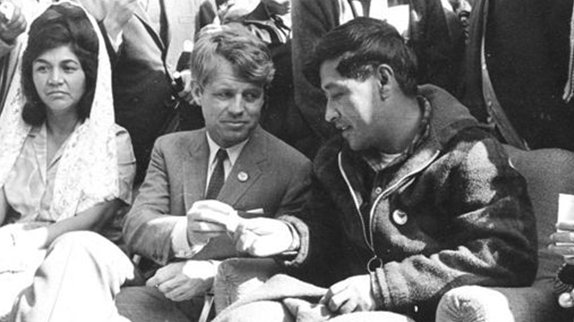He’s a modern-day hero now, with schools, bridges, libraries, parks and roads named after him. But back in the ’60s and ’70s, California’s agricultural oligarchy was hardly enamored of human rights activist César Chávez. That was especially true of grape growers, targets of the 5-year boycott that made Chávez famous.

[Photo of Chavez with a sign encouraging farm workers to “Huelga” – “Strike” – courtesy of Jay Galvin, Flickr/Creative Commons]
Ironically, although he spent his adult years trying to revolutionize the farming establishment, Chávez started life as one of them. Born in Yuma, Arizona this day in 1927, he spent his early years on the 100-acres-plus farm owned by his grandfather, Césario Chávez. But the family lost their farm in the Great Depression and went to California to labor in the fields as migrant workers.
After a wartime stint in the U.S. Navy, Chávez returned to the fields. He spent his spare hours reading and became a devotee of Mahatma Gandhi’s philosophy of social change through non-violence. His world was ready to erupt: migrant workers often went unpaid, got no medical care or schooling in the barrios, worked all day without bathroom breaks and endured other conditions difficult to imagine in today’s first-world lifestyle.
So in his mid-30s, Chávez began the slow process of organizing farm workers for better living and working conditions, and several years later his National Farm Workers Association joined with the AFL-CIO in their strike against vineyards in Delano, California.
Chávez became the national poster boy for underserved Americans – especially those in rural communities, and especially Latinos. Public pressure and support for the boycott was so strong that most growers caved, signing agreements to upgrade conditions for field workers. Chávez became the first man ever to organize a farm workers’ union that resulted in signed contracts, and shortly after the grape boycott ended in 1970, he went after lettuce growers. It didn’t impact the industry as much as the grape protest, but that mattered little; American consumers had awakened.

[Photo of Chávez, right, with Sen. Robert F. Kennedy. The woman to Kennedy’s right is Chavez’s wife, Helen. Courtesy of Korean Resource Center, Flickr/Creative Commons]
One feature of Chávez’s non-violent protest tactic was fasting. In 1968, to prevent violence during the grape strike, he went on a hunger strike for 25 days. His fast was broken at an outdoor Mass attended by 4,000 supporters, including Sen. Robert F. Kennedy.
Chávez conducted several more hunger strikes during his organizing career, and in the end it likely killed him. He died in his sleep in 1993 after fasting for several days – but while not all everything he accomplished was permanent, the most important changes – guaranteed pay for migrant workers, a 70 percent wage increase from 1964 to 1980, health care, schooling and a formal grievance policy – did endure. In 1994, President Bill Clinton awarded the U.S. Presidential Medal of Freedom to Chávez’s wife, fellow activist Helen Chávez, and in 2008, Presidential candidate Barack Obama adopted Chávez’s mantra, “Si se puede”–“Yes, we can”–as his own campaign slogan.
And I still have my “Boycott Grapes” bumper sticker.
What should we pour, then, to honor César Chávez on his birthday? It has to be a California varietal, don’t you think? A nice Cab or Merlot is the obvious choice, but they do so well with Zinfandel, I think that’s what I’ll drink tonight. And if you feel like a splurge, try a Schramsberg bubbly. Finally, Chávez would approve.
Wine Lingo of the Day: Alto Adige = Italy’s northernmost wine region. Perched at the very top of the country, Alto Adige sits in the Italian Alps (known as the Dolomites) and borders Austria and Switzerland. When you visit, you’ll drink lively whites with plenty of minerality- Pinot Grigio, Gewürztraminer and Sauvignon (as they call Sauvignon Blanc) – but you’ll find BigSexyReds here, too.
Cheers!
Mary